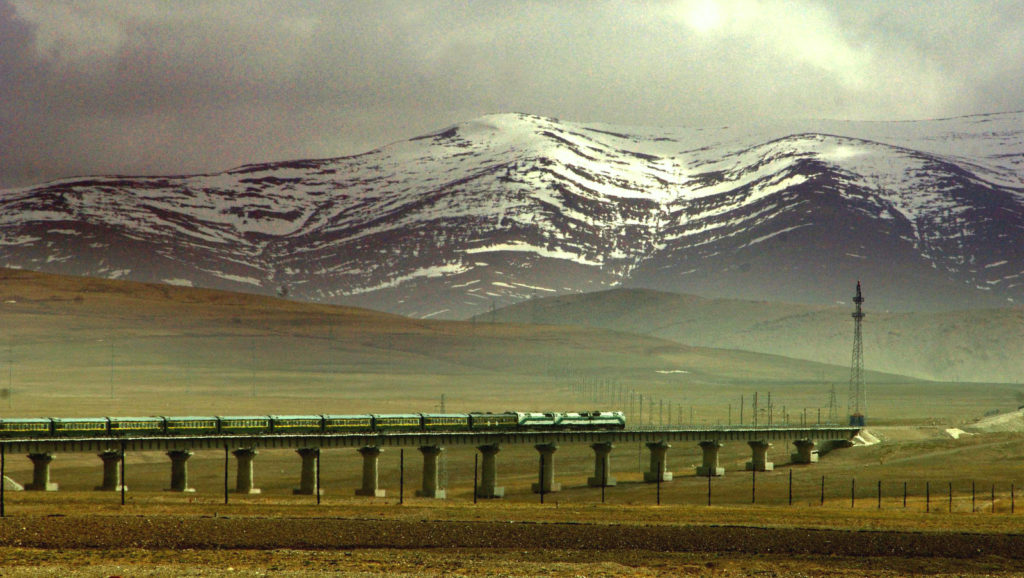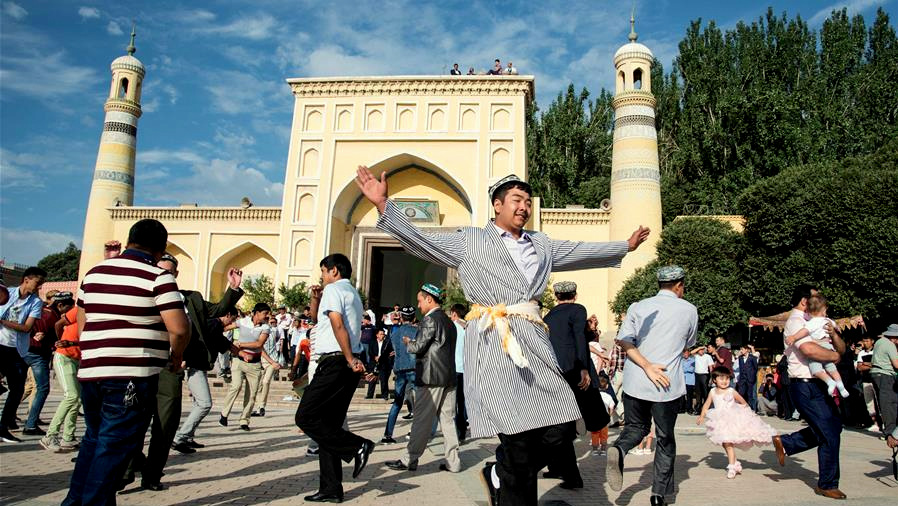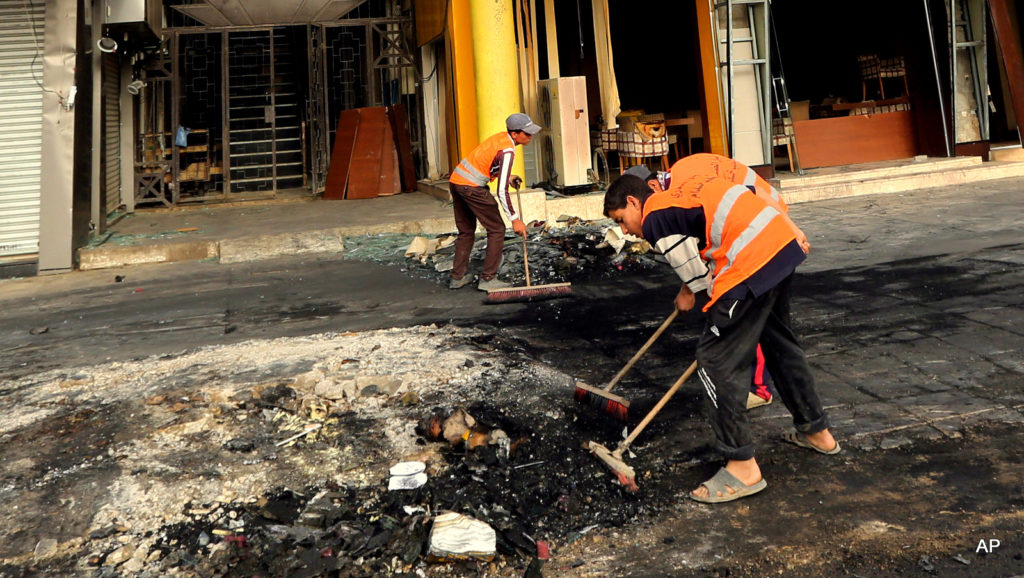China’s Strategy in Its ‘War on Terror’: Jobs Not Drones
BRICS, 6 Mar 2017
Caleb T. Maupin – MintPress News
The Chinese government is employing a unique strategy to reduce the threat of terrorism in its historically unstable Tibet and Xinjiang autonomous regions. By providing new jobs and better housing, the government has managed to quell the threat of separatism.

Chinese workers sew clothes at a garment factory in Wuqia town, Kuqa county, Aksu Prefecture, northwest China’s Xinjiang Uygur Autonomous Region, 27 September 2016. Photo: Imaginechina/AP
2 Mar 2017 — On March 1, 2014, eight men and women wielding knives attacked passengers at a train station in southwest China’s city of Kunming. The attackers, wielding long-bladed knives, killed 31 people and injured 143 others. Four of the attackers were killed by a SWAT team at the scene, while another three were executed in March 2015 for their involvement in the attack.
According to Chinese state media reports, the attackers were from the Xinjiang Uyghur Autonomous Region in northwest China and were linked to separatist groups. Xinjiang is home to China’s Islamic Uyghur minority group. Many Uyghurs, not just in China but around the world, hold deep resentment against the Chinese government for what they believe to be anti-religious and anti-Islamic policies. One example is last year’s demolition of mosques in Xinjiang, which officials said was done to protect public safety, as many of the mosques were dilapidated and unsafe.
Following the 2014 attack, terrorist groups Al-Qaeda and Daesh both announced support for Uyghur separatists, calling for them to escalate their violence, as well as advising Xinjiang to break away from China and become an independent state with a theocratic government. During roughly the same period, thousands of Uyghurs found their way to Syria and Iraq after receiving training in Afghanistan.

A worker picks cotton at an agriculture park in Hami City, northwest China’s Xinjiang Uygur Autonomous Region, Oct. 26, 2013. (Xinhua/Cai Zengle)
Terrorism Down, Standard of Living Up
But that was three years ago. What has happened since? Has Xinjiang gone the way of Iraq, Libya and Syria? Is an insurgency blazing across the countryside?
Not at all. Three years after the Kunming attackers carried out what has been called “China’s 9/11,” Xinjiang is actually more peaceful than before. What prevented the region from descending into chaos? Although China has stepped up its policing and security measures in the time since the attacks, a different factor has actually been more prominent in halting unrest and maintaining peace.
“An average of two new textile factories were set up in Xinjing every day last year. We expect to see more this year,” said Yin Xiaodong, director of Xinjiang’s textile industry management office. Xinjiang now has more than 1,800 textile factories, with 112,300 people working in textile mills. The Chinese government said it expects another 100,000 textile industry jobs to be created this year.
Rural Uyghurs who join China’s industrial workforce are likely seeing significant improvements in their standard of living. The wages of Chinese industrial workers are closely regulated by the state. Between 2008 and 2014, the average wage of China’s industrial workers increased by 71 percent. Business owners have complained about what they consider to be extreme workplace protections and wage controls. MarketWatch quotes Yang Keng, the owner of a major Chinese real estate company as saying “China, as a developing country, has adopted labor laws of a European welfare state. The motives are good but businesses have been hurt.”
The Chinese central government has also announced plans to develop new roads and railways in Xinjiang. In 2017, roughly 170 billion yuan (24.8 billion dollars) will be used to build new roads in the historically impoverished region. Another 8.1 billion yuan (1.18 billion dollars) will be used to build new railways. The Chinese government is also researching the possibility of building a high-speed railway that will connect Xinjiang’s capital of Urumqi to a land-port on the Sino-Kazakh border.
It is believed that the development of industry and infrastructure in the region has diminished the threat of separatist terrorism by giving impoverished Uyghurs more job opportunities and a better quality of life.

A train runs along the Qinghai-Tibet Railway in the section of Golmud, northwest China’s Qinghai Province.
AP/ Xinhua, Chen Xie
Stabilizing Tibet
Southwest China’s Tibet Autonomous Region also has a history of instability, the height of which was reached during the 1950s. Kenneth Conboy and James Morrison’s 2002 book “The CIA’s Secret War in Tibet” describes how the United States facilitated guerrilla warfare in the region at the time.
Gyalo Thondup, brother of the Dalai Lama, was given military training in Colorado along with a group of his followers. They were airdropped into the country with American-made weapons and attempted to reduce the country to a state of full-scale war by 1956, hoping to drive out the Communist Party of China and restore the feudal Buddhist kingdom. It is not known how many people died in the bloodbath that followed.
The most recent incident of violence and unrest in Tibet took place in March 2008. A riot that occurred that month left 18 people dead, as well as left 382 civilians and 241 police officers injured. U.S. media reports did not describe the incident as terrorism. But other reports indicate that mobs of Tibetan separatists attacked people on the streets of Lhasa, allegedly because they appeared to be of China’s majority Han ethnicity. Over 120 houses were destroyed in the riot, which was apparently inspired by calls from Tibetan separatists.
But Tibet has been relatively calm since 2008. Guerilla warfare, ethnic violence and arson seem to be on the decline. In recent years, Tibet has been the focus of much of the Chinese government’s poverty alleviation efforts.
Roughly 20 percent of Tibet’s population lives in poverty, according to government estimates. China Daily describes the life of Dashon, a 52-year old Tibetan woman who used to live in a primitive hut. “Our house could have collapsed at any minute, and we often feared for our safety,” she said.
Dashon now she lives in a modern two-story home with electricity and running water. She is one of 236,000 people who have been resettled into improved housing as the CPC works toward its stated goal of eliminating China’s poverty completely by 2020.
Over the next five years, the Chinese government intends to invest 18 billion yuan (2.5 billion dollars) in over 1,216 anti-poverty programs in the region. By moving impoverished Tibetans to more prosperous areas, the government will provide them with access to new jobs. Construction is under way on the Qinghai-Tibet Railway, which will connect the region with other parts of the country.
Tibet’s poverty alleviation office is making significant efforts to help impoverished Tibetans start new lives and find good-paying jobs in modern cities, far away from remote villages. “We have identified 11 different factors that help to explain why these people live in poverty, and different measures will be adopted for different people and different households to help lift them out of poverty,” said Lu Huadong, deputy head of the office.
Just as in people in Xinjiang have become less likely to join extremist groups with the arrival of new jobs, it seems that Tibetans who are provided with better housing and employment will also be less likely to join such groups and carry out terrorist attacks.

Muslims dance in front of the Id Kah Mosque in Kashgar, northwest China’s Xinjiang Uygur Autonomous Region, July 6, 2016. Photo: Xinhua/Bu Duomen
Respecting Religion and Tradition
Much of the resentment that Tibetan and Xinjiang separatist groups tap into is based on the historically anti-religious stance of the Communist Party of China. While the Chinese constitution declares religious freedom, the ruling Communist party bases itself on Marxism-Leninism and dialectical materialism.
Ian Johnson’s piece “China’s Great Awakening” points out that anti-religious fervor within the Chinese government did not originate with the CPC. Nationalist leader Dr. Sun Yat-sen, whose revolution created the Republic of China in 1912, was virulently anti-religious, with one his first revolutionary acts being the destruction of a temple. The National Party of China launched a campaign to “destroy superstition” as part of the “New Life Movement” in 1926.
The Communist Party of China’s policies toward religion have changed significantly since the birth of modern China. At first, the party made an effort to accommodate religion and tried to create pro-Communist associations among Buddhists, Catholics, Muslims and Taoists. These policies were gradually reversed during the 1950s.
From 1966 to 1976, China went through the Cultural Revolution, a mass government campaign that involved attempts to drastically push Chinese society closer to communist ideals. During this period, many Buddhist temples and mosques were destroyed. Those who practiced religion were subject to public humiliation and violent searches of their homes by young Communists organized into an association known as the Red Guard.
During this period, Buddhist or Catholic clergy who had taken vows of chastity were forced to marry. While pornography, promiscuity, homosexuality and extramarital sex were considered to be “bourgeois decadence” by the Communists, the promotion of celibacy was considered to be an open display of hostility to the party’s goal of increasing the population.
Following the rise of former Chinese leader Deng Xiaoping and the repudiation of the “Gang of Four,” the party began to lower its hostility toward those of religious faith. In 1982, the arty published a 20-page declaration entitled “The Basic Viewpoint and Policy on the Religious Question During Our Country’s Socialist Period.” The piece is more widely known as “Document 19” and it repudiates many of the anti-religious policies of the 1960s and 1970s. The document argues that Chinese leaders should show “respect for and protection of the freedom of religious belief,” despite maintaining a dialectical materialist, atheist worldview.
The party’s policies toward religion have ostensibly continued to soften since then. In April 2016, Chinese President Xi Jinping addressed China’s attitude toward religion, urging the Communist Party of China to “dig deep into doctrines and canons that are in line with social harmony and progress, and favorable for the building of a healthy and civilized society, and interpret religious doctrines in a way that is conducive to modern China’s progress and in line with our excellent traditional culture.”
In addition, he said “We must resolutely guard against overseas infiltrations via religious means and prevent ideological infringement by extremists,” a possible reference to the unrest in Xinjiang and the support for Uyghur separatists by Al-Queda and ISIS.
The use and manipulation of religious grievances by China’s enemies is certainly not new. As far back as 1957, U.S. Secretary of State John Foster Dulles said “the religions of the East are deeply rooted and have many precious values. Their spiritual beliefs cannot be reconciled with Communist atheism and materialism. That creates a common bond between us, and our task is to find it and develop it.”
In July 2016, the Chinese government sponsored a conference of Islamic leaders where they discussed how to oppose violence and extremism. 100 imams gathered, most from central Asia, to discuss how to stop terrorism from spreading among Muslims in the region.
President Xi has also announced that the country will “support the education of religious professionals to ensure they are fully prepared to carry out their duties and build the trust of believers.” This policy has included the expansion of the China Islamic Institute in Beijing, where young Muslims are trained to become religious leaders.
In Tibet, the policy of respecting religious groups and local culture seems to not only be stabilizing the region, but contributing to its economic prosperity. The region has seen increased tourism in recent years, with the industry bringing 33 billion yuan (4.8 billion dollars) to the historically impoverished region in 2016. Over 100,000 Tibetans enjoyed profits from tourism-related business endeavors. The money came from over 23 million tourists who poured into the region last year, with the number estimated to increase to 25 million this year.

Municipality workers clean up debris in the aftermath of a car bomb explosion in Baghdad’s western district of Mansour, Iraq, Tuesday, April 28, 2015.
Hadi Mizban/AP Photo
Jobs, not Drones
In the wake of the 9/11 terror attack, the U.S invaded Iraq, a country that had nothing to with the attacks. The country’s “shock and awe” bombing campaign destroyed much of the country’s infrastructure, including power plants and roads. Even years after the invasion, many Iraqis still do not have electricity or must depend on electricity that is imported from Iran.
Despite being waged on the basis of combating terrorism, the invasion has turned Iraq into a hotbed of extremism. Sections of Iraq are currently under the thumb of Daesh terrorists. Al-Qaeda also has a presence in the country. The toppling of the Baath Arab Socialist Party seems to have strengthened terrorism in Iraq and other parts of the world instead of reducing it.
Iraq is not alone in this regard. The U.S. is currently engaged in military operations in Iraq, Yemen, Pakistan, Somalia, Sudan, Syria and Afghanistan. These operations typically consist of drone strikes and bombing campaigns directed against alleged terrorists.
But after years of drone strikes, regime changes and other anti-terror efforts from the Pentagon, none of these countries appear to be more stable. In fact, many have them have seen unrest and civil strife increase in the wake of U.S. efforts to eliminate terrorism. The presence and strength of terrorist groups seems to have expanded since the dawn of the U.S. war on terror.
China, on the other hand, seems to have had the opposite experience. Its two most unstable and terror-ridden regions are now more stable than ever before, and all without the expense and destruction that drone strikes and bombing raids inflict.
Observers may deduce that perhaps raising standards of living is a better weapon in the war on terror than military might. Fighting terrorism seems to have more to do with building up historically impoverished communities instead of tearing them down.
_________________________________________
Caleb Maupin is a MintPress journalist and political analyst who resides in New York City focusing his coverage on US foreign policy and the global system of monopoly capitalism and imperialism.
Go to Original – mintpressnews.com
DISCLAIMER: The statements, views and opinions expressed in pieces republished here are solely those of the authors and do not necessarily represent those of TMS. In accordance with title 17 U.S.C. section 107, this material is distributed without profit to those who have expressed a prior interest in receiving the included information for research and educational purposes. TMS has no affiliation whatsoever with the originator of this article nor is TMS endorsed or sponsored by the originator. “GO TO ORIGINAL” links are provided as a convenience to our readers and allow for verification of authenticity. However, as originating pages are often updated by their originating host sites, the versions posted may not match the versions our readers view when clicking the “GO TO ORIGINAL” links. This site contains copyrighted material the use of which has not always been specifically authorized by the copyright owner. We are making such material available in our efforts to advance understanding of environmental, political, human rights, economic, democracy, scientific, and social justice issues, etc. We believe this constitutes a ‘fair use’ of any such copyrighted material as provided for in section 107 of the US Copyright Law. In accordance with Title 17 U.S.C. Section 107, the material on this site is distributed without profit to those who have expressed a prior interest in receiving the included information for research and educational purposes. For more information go to: http://www.law.cornell.edu/uscode/17/107.shtml. If you wish to use copyrighted material from this site for purposes of your own that go beyond ‘fair use’, you must obtain permission from the copyright owner.